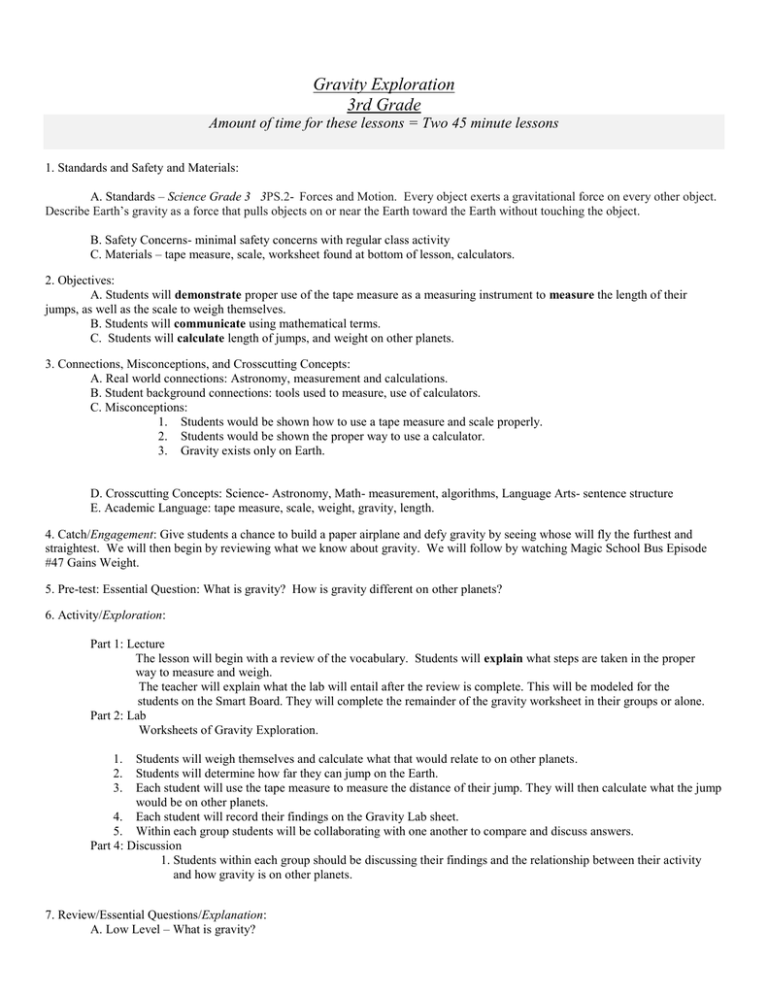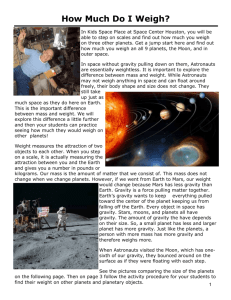Gravity
advertisement

Gravity Exploration 3rd Grade Amount of time for these lessons = Two 45 minute lessons 1. Standards and Safety and Materials: A. Standards – Science Grade 3 3PS.2- Forces and Motion. Every object exerts a gravitational force on every other object. Describe Earth’s gravity as a force that pulls objects on or near the Earth toward the Earth without touching the object. B. Safety Concerns- minimal safety concerns with regular class activity C. Materials – tape measure, scale, worksheet found at bottom of lesson, calculators. 2. Objectives: A. Students will demonstrate proper use of the tape measure as a measuring instrument to measure the length of their jumps, as well as the scale to weigh themselves. B. Students will communicate using mathematical terms. C. Students will calculate length of jumps, and weight on other planets. 3. Connections, Misconceptions, and Crosscutting Concepts: A. Real world connections: Astronomy, measurement and calculations. B. Student background connections: tools used to measure, use of calculators. C. Misconceptions: 1. Students would be shown how to use a tape measure and scale properly. 2. Students would be shown the proper way to use a calculator. 3. Gravity exists only on Earth. D. Crosscutting Concepts: Science- Astronomy, Math- measurement, algorithms, Language Arts- sentence structure E. Academic Language: tape measure, scale, weight, gravity, length. 4. Catch/Engagement: Give students a chance to build a paper airplane and defy gravity by seeing whose will fly the furthest and straightest. We will then begin by reviewing what we know about gravity. We will follow by watching Magic School Bus Episode #47 Gains Weight. 5. Pre-test: Essential Question: What is gravity? How is gravity different on other planets? 6. Activity/Exploration: Part 1: Lecture The lesson will begin with a review of the vocabulary. Students will explain what steps are taken in the proper way to measure and weigh. The teacher will explain what the lab will entail after the review is complete. This will be modeled for the students on the Smart Board. They will complete the remainder of the gravity worksheet in their groups or alone. Part 2: Lab Worksheets of Gravity Exploration. 1. 2. 3. Students will weigh themselves and calculate what that would relate to on other planets. Students will determine how far they can jump on the Earth. Each student will use the tape measure to measure the distance of their jump. They will then calculate what the jump would be on other planets. 4. Each student will record their findings on the Gravity Lab sheet. 5. Within each group students will be collaborating with one another to compare and discuss answers. Part 4: Discussion 1. Students within each group should be discussing their findings and the relationship between their activity and how gravity is on other planets. 7. Review/Essential Questions/Explanation: A. Low Level – What is gravity? B. Middle Level – By using the data collected from each group what patterns do you see? C. High Level – Explain the advantages and disadvantages of the way gravity behaves on other planets. 8. Assessments (Post-test)/Evaluation: A. Formative: Review of vocabulary, teacher will observe the students using the appropriate steps within their group. B. Post-test: Students will be asked on their exit tickets to answer essential questions and list one or two things they learned. The expectations for exit cards will be that the answers must be written in complete sentences. 9. Timeline A. Catch 15 minutes (paper airplanes) B. Pre-test 5 minutes C. Activity 2 parts 45 minutes each D. Review and Post-Test 15 minutes 10. Enrichment Students that finish early may help their classmates that are struggling. 11. IEP Accommodations/Differentiation/Diversity: 1. Students will be working within mixed ability groups. 2. Allow each student his or her own physical space within the group. 3. Pre-teaching vocabulary is especially important for ELL students. Gravity Exploration Name______________________________ Part A. How much would you weigh on other planets and the moon? The more mass a planet has, the more gravity it has. Planets which have more mass than Earth would have more gravity than Earth. A person would weigh more on these planets than they do on Earth. Location Moon Mercury Venus Mars Jupiter Saturn Uranus Neptune Weight on Earth X X X X X X X X Gravity 0.17 0.38 0.86 0.38 2.87 1.32 0.93 1.23 Calculated Weight = = = = = = = = Part B: How far could you jump on other planets and the moon? Determine how far you can jump on the Earth. To do this, place a piece of tape on the floor as a starting line. Jump as far as you can off of both feet. Have your partner mark where you land not where you end up! Measure the distance and record in the table. Do this five times, and then find the average. Jump 1 Location Moon Mercury Venus Mars Jupiter Saturn Uranus Neptune Conclusion: Jump 2 Jump 3 Jump 4 Average Length on Earth Jump 5 Gravity ÷ ÷ ÷ ÷ ÷ ÷ ÷ ÷ 0.17 0.38 0.86 0.38 2.87 1.32 0.93 1.23 Average Length = = = = = = = = 1. Complete each statement: A person would weigh more on ____________ than on _____________, because___________ __________________________________________________________________________________________ __________________________________________________________________________________________ _____________________________________________________. A person could jump further on _____________ than on _______________, because ______ __________________________________________________________________________________________ __________________________________________________________________________________________ _____________________________________________________.





